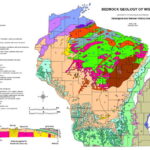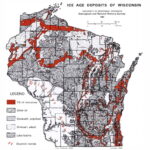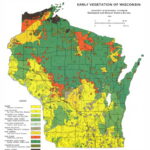Why Edge Effects?

So…why did we choose Edge Effects as the name for CHE’s official blog?
There are a lot of answers to this question. Some have to do with the history of ecology, some with the geography of Wisconsin, some with the institutional history of our university, some with the nature of conversations across academic disciplines, and all relate to core values of the Center for Culture, History, and Environment (CHE’s full name). Let me see if I can weave these together to show how they relate to what we’re hoping to do in this blog.

Frederic Edward Clements depicted a transect across an ecotone boundary in his classic manual on Plant Physiology and Ecology (New York: Henry Holt, 1907), 211.
Those familiar with the history of ecology will probably remember that the concept of ecological “edges” emerged in the early twentieth century to describe biological interactions happening on the boundaries between different plant formations and habitat types. Frederic Edward Clements, one of the most important founders of plant ecology in the United States, was responsible for introducing the word “ecotone” to describe such boundaries in his pioneering early study of Nebraska vegetation.1 For Clements, the ability to draw a boundary around distinct plant formations was an essential first step toward naming those formations and describing their characteristics, thus laying the foundation for all subsequent ecological analysis.
It was Wisconsin’s own Aldo Leopold, though, who emphasized the homelier word “edge” as a synonym for Clements’s ecotone, and who invented the label “edge effects” to describe interactions in the vicinity of such boundaries. In his 1933 classic Game Management, Leopold followed his usual habit of combining the dispassionate insights of an ecologist with those of a practiced woodsman and hunter to declare that “game is a phenomenon of edges. It occurs where the types of food and cover which it needs come together, i.e., where their edges meet. Every grouse hunter knows this when he selects the edge of a woods, with its grape tangles, haw-bushes, and little grassy bays, as the likely place to look for birds.”2 For a creature like the white-tailed deer, nibbling plants near an edge was a way to take advantage of the food associated with exposed grasslands and marshes without straying too far from the protective cover of the forest.
Leopold’s argument was that many species sought out edges because of the variety of resources available near such boundaries. “We do not understand the reason for all of these edge-effects,” he wrote, “but in those cases where we can guess the reason, it usually harks back either to the desirability of simultaneous access to more than one environmental type, or the greater richness of border vegetation, or both.” Although he knew he lacked the data to quantify this insight, he believed that edges were places where different species were often present in greater numbers, variety, and density than elsewhere. “An acre of fencerow or hedge,” he declared, “consisting, so to speak, entirely of edges, usually has more game (and songbirds also) than many acres of unbroken woods, or wheat, or corn.” If this was true, then a good conservationist seeking to be the best possible steward for land and wildlife should foster such edge effects to promote the abundance and diversity of organisms on a given tract of land.

Aldo Leopold with his dog Flick on an ecological edge between field and forest, c. 1944. Photo courtesy of the Aldo Leopold Foundation. Click to enlarge.
The meeting and mixing of different organisms and natural features that occurs where Leopoldian edges meet is not limited to cornfields and woodlots, since geographical boundaries are fractal and operate on every conceivable scale. Geologists and ecologists have for more than a century characterized Wisconsin as a place where very different geographies—many of them operating on continental scales—meet and express their boundaries. We sit, for instance, on the watershed between the Great Lakes and the Mississippi Valley, so that some of our streams and rivers flow to the North Atlantic and others to the Gulf of Mexico. Bedrock in the northern part of our state is more ancient by nearly a billion years than bedrock in the south, and these different geologies affect everything from farming to tourism to frac sand mining. Continental glaciers have covered Wisconsin multiple times, the most recent (which is named for the state) having departed less than 15,000 years ago, leaving behind fertile agricultural soils in some parts of the state and poorly drained wetlands elsewhere. Only one part of Wisconsin—the Driftless Area, in the southwest—has never been glaciated, and its topography is utterly different from everywhere else. The edge between glaciated and unglaciated regions of the state is among its most defining features. Prevailing air masses produce very different temperatures, precipitation patterns, and growing seasons in the northern and southern parts of the state, and these combine with bedrock, glacial artifacts, and soils to yield the boundaries between forests, savannahs, and prairies that were so much on Leopold’s mind when he wrote about edge effects. Everything about the state’s history and geography has been shaped by these many boundaries and the edge effects that go with them.



One obvious answer to why we chose the title Edge Effects for our CHE blog, then, is our desire to echo Leopold’s insight that edges are places where very different kinds of creatures (and people) come together, mingle, and change. That seems to us to be an attractive metaphor for CHE itself, since we seek to be a welcoming home for scholars and scientists from any and all disciplines who share our passion for trying to understand how human beings interact with the rest of the natural world. Disciplines represented among the dozens of us associated with CHE range from the natural and social sciences to the arts and humanities, from history and geography to ecology and literary studies, from landscape architecture to community and environmental sociology, from anthropology to botany and chemistry, from art history to history of science, from engineering to entomology, and so on. Although all of us in CHE study past and present environmental change as it relates to human beings and human cultures, we approach this topic in so many different ways—with so many different questions and perspectives and methods that reflect our different disciplinary backgrounds—that we’ve all come to recognize that none of us can hope to understand such complicated phenomena by ourselves. It’s only when we cross the edges of our disciplines to enter what we half-jokingly call “CHE-Space” that we start sharing and hybridizing our knowledge. That’s when all sorts of new learning and insights begin. CHE-Space is a place of intellectual edge effects.
This kind of interdisciplinary knowledge-seeking and knowledge–making reflect a very long tradition at the University of Wisconsin-Madison. Founded in 1848 and expanded under the 1862 Morrill Act to receive the state’s educational land grant, the UW is one of the very few research universities in the country where the traditional liberal arts institution and the new land grant agricultural and engineering schools of the mid-nineteenth century were combined into a single integrated whole. In most states, the “University of X” originated as a liberal arts school (think University of Michigan, University of Iowa, University of Oregon) whereas the “X State University” received the land grant to provide a home for engineering and agricultural science (think Michigan State, Iowa State, Oregon State). In Wisconsin, the legislature insisted (over the strenuous objections of Madison’s liberal arts faculty) that these all be housed in one university. The unintended consequence was that ideas began moving freely among academic disciplines that often aren’t even on the same campus at many other institutions.

A flock of sheep grazing on the campus below the University of Wisconsin’s Agriculture Hall in the 1920s was evidence of the institution’s land grant traditions that made it so unusual. Courtesy UW-Madison Department of Life Science Communications. Click to enlarge.
These disciplinary “edge effects” mean that the much-contested boundary between pure and applied knowledge have never meant as much at Wisconsin as it did elsewhere. Perhaps that is why so many students and faculty members in so many departments and programs were drawn beyond their own disciplinary boundaries as they grappled with questions of natural processes and social policies and human well-being. This was especially true for environmental topics, where the university quickly distinguished itself as a pioneer in many fields. Aldo Leopold is certainly among the best-known representatives of this tradition, but he is hardly alone. Frederick Jackson Turner reinterpreted the whole sweep of American history in terms of the nation’s relationship with land. Edward A. Birge helped invent the science of limnology using Madison’s famed lakes as objects of study. John T. Curtis helped reinvent plant ecology by producing a state-wide survey of the Vegetation of Wisconsin that for the first time organized a state flora on ecological principles while also paying close attention to historical changes in human land use. Curtis, Leopold, and other scientists pooled their insights to create the first arboretum in the world organized by ecological habitat rather than Linnaean taxonomy. Franklin Hiram King studied Chinese cropping techniques to promote the study of sustainable agriculture. James Willard Hurst transformed the field of American legal history in part by focusing on the role of law in shaping natural resource use. And the geologist Charles Richard Van Hise in 1910 wrote the first textbook of natural resource conservation ever published in the United States.

University of Wisconsin President Charles Richard Van Hise (left) and his friend Governor Robert M. La Follette, Sr. (right) were jointly responsible for the special relationship between the university and the state government that Charles McCarthy labeled as “The Wisconsin Idea” in a book with that title published in 1912. Van Hise photo 1904, Wikimedia Commons; La Follette photo Wikimedia Commons. Click to Enlarge.
Science and scholarship of this sort—applying the most rigorous academic knowledge to the study and solution of real-world problems—came to be known by the early twentieth century as “The Wisconsin Idea.” Van Hise declared in 1904 that “I shall never be content until the beneficent influence of the University reaches every family in the state.” Partnering with his old college roommate Robert M. La Follette, the Republican governor who became one of the most famous Progressive leaders of his generation, Van Hise encouraged UW faculty members to work with the governor’s aides and with state legislators to devise new policies that would benefit the people of Wisconsin and citizens of the United States more broadly.
It used to be said of the Wisconsin Idea that “the boundaries of the university are the boundaries of the state”; we now extend that sentence to include not just the state, but the nation and the world. Still, the core value remains the same: the University of Wisconsin has never believed in building or defending an ivory tower, because its most interesting work has typically taken place on the boundaries where academia intersects with the wider world. In that sense, the Wisconsin Idea is yet another edge effect that CHE tries to support whenever and wherever it can.
I shouldn’t close without acknowledging that ecology today takes a dimmer view of edge effects than Aldo Leopold did when he first introduced the concept. With the emergence of island biogeography in the 1970s, and with growing concern among biologists about the threat that habitat fragmentation represents for vulnerable species all over the world, the edges that seemed so abundant and diverse to Leopold now often seem less benign. Edge effects can be dangerous, even lethal, if we fail to attend as carefully as we can not just to the benefits but also to the risks that occur when crossing boundaries.
Perhaps there’s a valuable analogy in this even for the positive edge effects we seek when we talk across disciplinary and cultural divides. When environmental humanists and scientists traverse disciplinary boundaries in search of enhanced understanding, our goal should not be to abandon disciplinary knowledge, but to broaden its contexts while testing its limits as responsibly and respectfully as we can. Edge effects are valuable precisely because they occur where habitats and cultures and disciplines are marked by meaningful boundaries.
There’s a moral here that I hope we can honor as much in this blog as we try to do in CHE more generally: when former strangers leave their disciplinary comfort zones to inhabit a newly shared home together, it’s best to do a lot of listening so as to learn as much as we can about our companions in the common space we’re creating with each other’s ideas. The better we know and understand one another, the easier it is to foster the mutual recognition and respect that enable us to learn and live together.
Recognition and respect in the service of shared knowing and understanding: these too can be edge effects, honoring differences and similarities alike. More than anything else, they are what we hope to nurture in the digital commons we’re making together in this blog called Edge Effects.
William Cronon is Frederick Jackson Turner and Vilas Research Professor of History, Geography, and Environmental Studies at the University of Wisconsin–Madison. An environmental historian, he is currently completing a book entitled “Saving Nature in Time: The Environmental Past and the Human Future,” and is also writing a history of Portage, Wisconsin from the late Pleistocene to the present. Website. Contact.
This is really fantastic. Although I’m familiar with many of these intersecting stories individually, the way that you have brought them together into such an elegant tale is breathtaking. I’m in deeper awe of CHE, UW, Wisconsin, and now Edge Effects than ever before! So eager to follow along and read more.
Great blog. Keep up the good work.
I agree with Anna. In particular, the best way of approaching edge effects is by reading, because I live in another part of the planet. Nevertheless, by reading Cronon’s article and other CHE participants I learn to recognize how valuable is the place I live. Besides, I always foster interdisciplinary research. As Cronon says here, it is the best way to learn and respect each other.